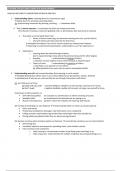Summary
Summary for Social Psychology
- Course
- Institution
Professor is Carolyn Decklerck. I think some political science people also have this course. This is a short but sufficient summary of Social Pyschology, I obtained a 14/20 studying this summary only. I advise you to also take a brief look at the research papers talked about in class when studying.
[Show more]



